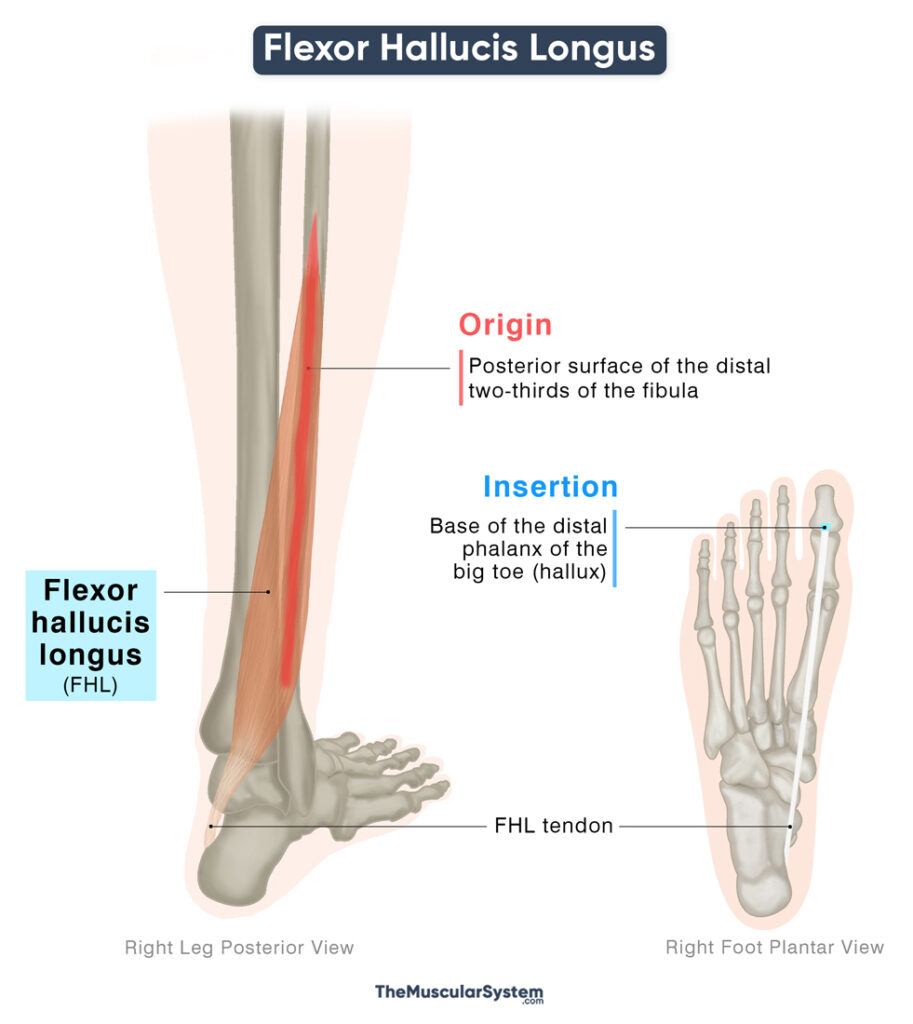Flexor Hallucis Longus
Last updated:
18/09/2025Della Barnes, an MS Anatomy graduate, blends medical research with accessible writing, simplifying complex anatomy for a better understanding and appreciation of human anatomy.
What is the Flexor Hallucis Longus
The flexor hallucis longus, also referred to as FHL, is a thin, long, bipennate muscle located deep on the fibular side at the back of the lower calf region. It belongs to the deep posterior compartment of the lower leg, with the flexor digitorum longus, tibialis posterior, and popliteus muscles.
As its name suggests, the FHL flexes the hallux (big toe). This action is essential for activities requiring powerful toe-off, such as walking, running, jumping, and dancing.
Anatomy
Location and Attachments
| Origin | Posterior surface of the distal two-thirds of the fibula |
| Insertion | The base of the distal phalanx of the hallux (on the plantar surface) |
Origin
The muscle originates primarily from the inferior two-thirds of the posterior surface of the fibula. Some part of the muscle also originates from the following points:
- The lower part of the interosseous membrane, which separates the tibia and fibula.
- On the lateral side, a small part of the muscle arises from the intermuscular septum shared with the fibularis muscles.
- On the medial side, it takes origin from the deep fascia covering the tibialis posterior.
Insertion
From its point of origin, the muscle descends vertically toward the ankle, with the muscle belly giving rise to a long, narrow tendon near the distal end of the fibula. The tendon travels through a shallow groove on the posterior tibia.
At the ankle, the tendon enters the tarsal tunnel on the medial side, where it is held in place by the flexor retinaculum. It then curves around the back of the talus and continues beneath the calcaneus, passing over the sustentaculum tali, a bony projection that supports the talus.
As it enters the sole of the foot, the tendon runs forward and enters the fibrous digital sheath of the big toe. It then proceeds to insert into the base of the distal phalanx of the big toe (hallux) on the plantar surface of the foot.
Relations With Surrounding Muscles and Structures
In the lower leg: The muscle lies deep to the gastrocnemius and soleus, which together form the triceps surae. They are separated from the FHL by the deep transverse fascia of the leg. Laterally, it is related to the fibularis longus and brevis muscles. Medial to the FHL are the tibialis posterior muscle and the posterior tibial artery, vein, and the tibial nerve. Deep to the muscle are the fibula, fibular artery, and fibular vein.
At the ankle (tarsal tunnel): The FHL tendon is the most lateral structure within the tarsal tunnel, positioned adjacent to the tibial nerve.
In the sole: After emerging from the tarsal tunnel, the tendon is crossed obliquely by the flexor digitorum longus tendon. It then passes between the two heads of the flexor hallucis brevis before entering the fibrous digital sheath of the big toe.
Variation
In most people, there is a muscular slip that runs from the flexor digitorum longus to the flexor hallucis longus. In some rare cases, there is an extra muscle slip, called the peroneocalcaneus internus. It starts from the FHL near the distal fibula and travels over the sustentaculum tali to attach to the calcaneus (heel bone).
Function
| Action | Flexing the big toe at all its joints, and helping with plantar flexion |
Its primary action is to flex the interphalangeal joint of the big toe and the first metatarsophalangeal joint. This function is vital during the terminal stance and pre-swing (toe-off) phases of the gait cycle, where the FHL provides a strong push-off that propels the body forward in walking, running, and jumping.
When the foot is in contact with the ground, the FHL works in coordination with the intrinsic foot muscles to press the big toe firmly against the surface, thereby enhancing balance and stability. Beyond its primary role, the muscle also contributes to plantar flexion and inversion of the foot; however, these actions are more dominantly performed by the superficial posterior compartment muscles such as the gastrocnemius, soleus, and plantaris.
Another function of the FHL is supporting the medial longitudinal arch. Acting like a bowstring, it works with the tibialis posterior to help maintain the arch’s shape and integrity during movement. The FHL remains mostly inactive when standing, only activating when you shift your balance or move your foot.
Antagonists
Acting in opposition to the FHL are the extensor hallucis longus and extensor hallucis brevis, which function to extend the great toe.
Innervation
| Nerve | Tibial nerve (S2-S3) |
The muscle receives innervation from the tibial nerve, a branch of the sciatic nerve. The branches supplying the muscle arise from the second and third sacral nerve roots (S2-S3).
Blood Supply
| Artery | Muscular branches of the fibular artery |
Its blood supply comes from muscular branches of the fibular (peroneal) artery, which arises from the posterior tibial artery.
References
- Flexor Hallucis Longus: Elsevier.com
- Anatomy, Bony Pelvis and Lower Limb: Calf Flexor Hallucis Longus Muscle: NCBI.NLM.NIH.gov
- Flexor Hallucis Longus Muscle: Kenhub.com
- Flexor Hallucis Longus: Rad.UW.edu
- Flexor Hallucis Longus: Radiopaedia.org
- Flexor Hallucis Longus: TeachMeAnatomy.info
Della Barnes, an MS Anatomy graduate, blends medical research with accessible writing, simplifying complex anatomy for a better understanding and appreciation of human anatomy.
- Latest Posts by Della Barnes, MS Anatomy
-
Digastric
- -
Stylohyoid
- -
Mylohyoid
- All Posts






